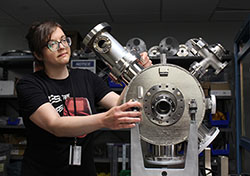Welcome to FRIB
The Facility for Rare Isotope Beams (FRIB) at Michigan State University (MSU) is a world-class research and training center, hosting the most powerful rare isotope accelerator. MSU operates FRIB as a user facility for the U.S. Department of Energy Office of Science (DOE-SC), with financial support from and furthering the mission of the DOE-SC Office of Nuclear Physics. FRIB allows MSU graduate students to engage in groundbreaking research in tandem with their coursework. Open the doors to discovery with the newest and most advanced rare isotope research facility and the world's most powerful rare isotope accelerator. Apply and inquire through FRIB’s graduate studies page at frib.msu.edu/grad.








